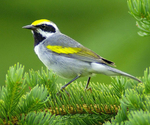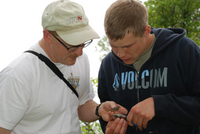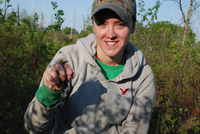Minnesota is home to 40% of the Golden-winged Warbler population, yet very little is known about this small forest songbird. Research by a professor at the University of Minnesota will help answer questions about the species currently under consideration for placement on the Threatened Species list by the U.S. Fish and Wildlife Service.
about this small forest songbird. Research by a professor at the University of Minnesota will help answer questions about the species currently under consideration for placement on the Threatened Species list by the U.S. Fish and Wildlife Service.
Four undergraduate students worked with Associate Professor John Loegering over the summer in an effort to gather information about the golden-winged warbler and its habitat. The project is part of the Golden-winged Warbler Conservation Initiative, a 4-year, 11-state collaboration to conduct research and develop conservation strategies throughout the range of the species. Loegering, who teaches ornithology on the Crookston campus, is widely known for his teaching and research in the field of natural resources.
"The golden-winged warbler can disappear quickly from an area once its habitat is threatened," Loegering says. "Our concern revolves around the declining population of this vulnerable species and developing effective strategies to preserve them. We need to bring this concern into the public consciousness."
 In February 2010, the U.S. Fish and Wildlife Service received a petition to list the species as threatened under the Endangered Species Act. In the past, only a few studies have been conducted noting the presence and/or absence of the birds making this research of particular significance. Loegering is intent on gathering information to answer the basic research questions: where do the birds occur, how productive are they, how many survive the migration to and from Columbia each winter, and what vegetative characteristics are associated with the most productive habitat. He is currently on a team to develop a conservation strategy and management prescriptions for the species throughout its range.
In February 2010, the U.S. Fish and Wildlife Service received a petition to list the species as threatened under the Endangered Species Act. In the past, only a few studies have been conducted noting the presence and/or absence of the birds making this research of particular significance. Loegering is intent on gathering information to answer the basic research questions: where do the birds occur, how productive are they, how many survive the migration to and from Columbia each winter, and what vegetative characteristics are associated with the most productive habitat. He is currently on a team to develop a conservation strategy and management prescriptions for the species throughout its range.
The small, gray songbird with its striking yellow and white markings arrives early in the spring and begins its migration early in the fall to its winter home in southern Central America and northern South America.
northern South America.
Loegering's research was conducted in the Tamarac National Wildlife Refuge, located near White Earth, Minn. It centered on locating singing golden-winged warbler males, mapping their territories, capturing and color-banding birds for subsequent identification, finding nests, documenting reproductive productivity and quantifying the habitat.
Loegering credits his field crew for their dedication. "Nests are incredibly difficult to find. It takes great patience and observation skills. This year we found more nests than were previously discovered in Wisconsin and Minnesota combined," he says.
 and Haarstad banding-thumb-200x134-52661.jpg) Work started early for the students beginning 30 minutes before sunrise often in the midst of intolerable attacks by insects and constant threat of Lyme Disease, a tick borne illness, but the students relished their work. Involved in the project were two recent graduates, Ben Haarstad, Pelican Rapids, Minn.; and Claire Hanson, King, Wis.; along with Senior Mike Johnson, Centerville, Minn.; and Freshman Josh Bruggman, Cologne, Minn. All are natural resources majors on the Crookston campus.
Work started early for the students beginning 30 minutes before sunrise often in the midst of intolerable attacks by insects and constant threat of Lyme Disease, a tick borne illness, but the students relished their work. Involved in the project were two recent graduates, Ben Haarstad, Pelican Rapids, Minn.; and Claire Hanson, King, Wis.; along with Senior Mike Johnson, Centerville, Minn.; and Freshman Josh Bruggman, Cologne, Minn. All are natural resources majors on the Crookston campus.
Loegering is jointly appointed to both the U of M, Crookston campus where his focus is on undergraduate education and the U of M, Twin Cities campus where he is focused on outreach and research as a wildlife specialist for the U of M Extension Service.
Today the University of Minnesota, Crookston delivers 29 bachelor's degree programs, 18 minors, and more than 40 concentrations, including several online degrees, in the areas of agriculture and natural resources; business; liberal arts and education; and math, science and technology. With an enrollment of about 1,300 undergraduates from more than 25 countries and 40 states, the Crookston campus offers a supportive, close-knit atmosphere that leads to a prestigious University of Minnesota degree. "Small Campus. Big Degree." To learn more, visit www.umcrookston.edu.
In the photos:
Top, right: Golden-winged warbler
Middle, left: John Loegering (left) and Mike Johnson band a 4-day-old golden-winged warbler chick.
Middle, right: Claire Hanson shows off a golden-winged warbler she just finished banding.
Bottom, left: Claire Hanson (left) and Ben Haarstad (right) put unique color bands on a male golden-winged warbler.
 about this small forest songbird. Research by a professor at the University of Minnesota will help answer questions about the species currently under consideration for placement on the Threatened Species list by the U.S. Fish and Wildlife Service.
about this small forest songbird. Research by a professor at the University of Minnesota will help answer questions about the species currently under consideration for placement on the Threatened Species list by the U.S. Fish and Wildlife Service.Four undergraduate students worked with Associate Professor John Loegering over the summer in an effort to gather information about the golden-winged warbler and its habitat. The project is part of the Golden-winged Warbler Conservation Initiative, a 4-year, 11-state collaboration to conduct research and develop conservation strategies throughout the range of the species. Loegering, who teaches ornithology on the Crookston campus, is widely known for his teaching and research in the field of natural resources.
"The golden-winged warbler can disappear quickly from an area once its habitat is threatened," Loegering says. "Our concern revolves around the declining population of this vulnerable species and developing effective strategies to preserve them. We need to bring this concern into the public consciousness."
 In February 2010, the U.S. Fish and Wildlife Service received a petition to list the species as threatened under the Endangered Species Act. In the past, only a few studies have been conducted noting the presence and/or absence of the birds making this research of particular significance. Loegering is intent on gathering information to answer the basic research questions: where do the birds occur, how productive are they, how many survive the migration to and from Columbia each winter, and what vegetative characteristics are associated with the most productive habitat. He is currently on a team to develop a conservation strategy and management prescriptions for the species throughout its range.
In February 2010, the U.S. Fish and Wildlife Service received a petition to list the species as threatened under the Endangered Species Act. In the past, only a few studies have been conducted noting the presence and/or absence of the birds making this research of particular significance. Loegering is intent on gathering information to answer the basic research questions: where do the birds occur, how productive are they, how many survive the migration to and from Columbia each winter, and what vegetative characteristics are associated with the most productive habitat. He is currently on a team to develop a conservation strategy and management prescriptions for the species throughout its range.The small, gray songbird with its striking yellow and white markings arrives early in the spring and begins its migration early in the fall to its winter home in southern Central America and
 northern South America.
northern South America.Loegering's research was conducted in the Tamarac National Wildlife Refuge, located near White Earth, Minn. It centered on locating singing golden-winged warbler males, mapping their territories, capturing and color-banding birds for subsequent identification, finding nests, documenting reproductive productivity and quantifying the habitat.
Loegering credits his field crew for their dedication. "Nests are incredibly difficult to find. It takes great patience and observation skills. This year we found more nests than were previously discovered in Wisconsin and Minnesota combined," he says.
 and Haarstad banding-thumb-200x134-52661.jpg) Work started early for the students beginning 30 minutes before sunrise often in the midst of intolerable attacks by insects and constant threat of Lyme Disease, a tick borne illness, but the students relished their work. Involved in the project were two recent graduates, Ben Haarstad, Pelican Rapids, Minn.; and Claire Hanson, King, Wis.; along with Senior Mike Johnson, Centerville, Minn.; and Freshman Josh Bruggman, Cologne, Minn. All are natural resources majors on the Crookston campus.
Work started early for the students beginning 30 minutes before sunrise often in the midst of intolerable attacks by insects and constant threat of Lyme Disease, a tick borne illness, but the students relished their work. Involved in the project were two recent graduates, Ben Haarstad, Pelican Rapids, Minn.; and Claire Hanson, King, Wis.; along with Senior Mike Johnson, Centerville, Minn.; and Freshman Josh Bruggman, Cologne, Minn. All are natural resources majors on the Crookston campus.Loegering is jointly appointed to both the U of M, Crookston campus where his focus is on undergraduate education and the U of M, Twin Cities campus where he is focused on outreach and research as a wildlife specialist for the U of M Extension Service.
Today the University of Minnesota, Crookston delivers 29 bachelor's degree programs, 18 minors, and more than 40 concentrations, including several online degrees, in the areas of agriculture and natural resources; business; liberal arts and education; and math, science and technology. With an enrollment of about 1,300 undergraduates from more than 25 countries and 40 states, the Crookston campus offers a supportive, close-knit atmosphere that leads to a prestigious University of Minnesota degree. "Small Campus. Big Degree." To learn more, visit www.umcrookston.edu.
In the photos:
Top, right: Golden-winged warbler
Middle, left: John Loegering (left) and Mike Johnson band a 4-day-old golden-winged warbler chick.
Middle, right: Claire Hanson shows off a golden-winged warbler she just finished banding.
Bottom, left: Claire Hanson (left) and Ben Haarstad (right) put unique color bands on a male golden-winged warbler.
Contact: : John Loegering, associate professor and extension wildlife specialist, natural resources, 218-281-8132 (jloegeri@umn.edu); Elizabeth Tollefson, assistant director, communications, 218-281-8432 (ltollefs@umn.edu)

